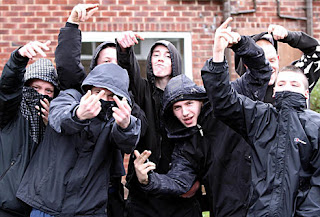Scri
Q1 How does the media represent collective groups of people (teenagers) in different ways?
Teenagers are often portrayed in the media as anti-social thugs that all drink, smoke, partake in pointless acts of crime that have sexual intercourse on a daily basis transmitting thousands of STI’s. "Almost all of the publicity that the media gives to young people is negative"- David Seymour, the Political Editor of the Mirror group.
‘Images of teens smoking, drinking, condoms etc’
These factors are true to some extent but the media magnifies these situations frequently focusing on the negatives, typically stereotyping all teens as ruthless thugs who lack in self-respect.
Many people complain about the view the media has on teens and state that ‘children are the future’ and that they are misrepresented. This is not entirely true in most cases as there are many teens that act in exactly the way the media portrays them. This relates to Judith Butlers theory of ‘performativity.’
‘Image of Judith Butler’
She argues that identities are a performance of day-to-day life. It’s not about who you are, it’s about what you do and how you ‘perform’. It can be said that the majority of teenagers are performing in a way they believe is expected of them- they are performing to societies expectations.
The riots in 2011 ‘Images of riots’ are an example of this. The images found in the newspapers look as though the teens are acting out scenes from Kidulthood. ‘Images of riots from newspapers’. Were they just performing, just acting up to the expectations the public have of them?
Stories in newspapers of human interest rarely feature young people and they are rarely approached by the mainstream media to give their opinions and views on issues. This leaves teens destined to be represented only in stories about gang crime, other criminal activities and more. By featuring stories about anti-social behavior, gang crime, drug and alcohol abuse and other criminal activities the press generate strong feelings of often moral outrage from society.
‘Images from newspapers’
This is why they love to feature stories about failing teens. "Some newspapers aren't interested in young people having a voice, because either it doesn't fit in with what they're generally writing or saying, or because they don't even think it's an issue." - David Seymour, the Political Editor of the Mirror group.
'Our 15 year-old girls lead the world in boozing, obesity and taking drugs.'
In a few paragraphs the media can convince the newspapers reader's that all teenage girls were overweight slobs, who spend hours slumped in front of the television drinking alcohol and smoking drugs. Many stereotypical views, similar to this one are seen across the media.
Another media institution, which represents teenagers in a negative light, is television. There are many TV programmes which stereotype the younger generation showing the bad side of teens.
‘Images of television programmes- Skins, Misfits, Top Dog’
Skins follows a group of British teenagers in their two years at college. Its controversial storylines have explored a vast amount of issues such as disfunctional families, mental illness, adolescent sexuality, drug and alcohol abuse and death. Teenagers in the programme are portrayed as self-absorbed, followers, rebellious, greedy people that fail to see the real importance in life.
‘Image of Skins cast’
On one hand, Skins shows a true representation of what most teenagers 'get up to', but on the other hand it displays a negative view on teens in our society today, stereotyping them. In the first episode we’re introduced to the characters Tony and Sid. The first storyline we are introduced to tells us how Tony is trying to help his mate, Sid lose his virginity. This displays teenagers as sex crazed lunatics. The second storyline in which we are made aware of is of Sid and Tony trying to buy some drugs for a party in order to have a wild and crazy night. This shows how teenagers feel the need to put 'crap' into their bodies in order to have a good time.
‘Images of drugs at the party’
‘Trailer of Skins series 1’
The trailer contains over fifty clip changes containing different shots of the teenagers, throwing foam, dancing, drinking, frequently removing clothes and doing unsavory things to one another. These shots all contribute in displaying a negative image of teens. In the first half of the clip the teens are all seen as energetic and seem to be having fun, dancing, drinking and 'getting off with each other.' The shots of them kissing and removing their clothing shows an image of teens as being promiscuous sex animals. Ten seconds into the trailer, a girl writes of one of the boys heads 'virgin', this shows how teens are concerned about being a virgin and when someone is they are usually ridiculed for it, showing how the teens are obsessed with sexual activities’. Up until 17 seconds into the trailer, things take a turn for the worst. The teenagers begin to take drugs; nos, pills, cannabis and they begin the come up on a 'high'. The pace of the trailer remains the same but begins to slow down to capture one of the girls faces as she 'comes up'. ‘Image of girl’ This shot captures the girl’s happiness from taking the drugs, depicting a negative image of teens that frequently take drugs and think that it's cool.
Half way through the video the characters begin to start throwing up and get into states where they don't know what’s going on due to the alcohol and drugs. This balances out the video and shows the negative inflections of drugs and alcohol and how a typical teenage house party usually ends horrendously with everyone making a mess of themselves. This shows how teens are not aware of limits and how they are just interested in getting absolutely wrecked not thinking of the consequences.



























